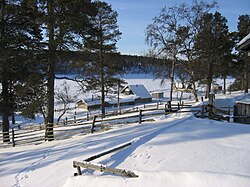Lovozersky District
Ловозерский район | |
|---|---|
 View of the selo of Kanevka in Lovozersky District | |
 Location of Lovozersky District in Murmansk Oblast | |
| Coordinates: 67°00′N 38°00′E / 67.000°N 38.000°E | |
| Country | Russia |
| Federal subject | Murmansk Oblast[1] |
| Established | August 1, 1927[2][3] |
| Administrative center | Lovozero[1] |
| Government | |
| • Type | Local government |
| • Body | Council of Deputies[4] |
| • Head[4] | Dmitry Pisarev[5] |
| Area | |
| • Total | 53,800 km2 (20,800 sq mi) |
| Population | |
| • Total | 11,820 |
| • Density | 0.22/km2 (0.57/sq mi) |
| • Urban | 71.2% |
| • Rural | 28.8% |
| Administrative structure | |
| • Inhabited localities | 1 Urban-type settlements[8], 4 rural localities |
| Municipal structure | |
| • Municipally incorporated as | Lovozersky Municipal District[9] |
| • Municipal divisions[9] | 1 urban settlements, 1 rural settlements |
| Time zone | UTC+3 (MSK |
| OKTMO ID | 47610000 |
| Website | http://www.lovozeroadm.ru/ |
Lovozersky District (Russian: Лово́зерский райо́н) is an administrative district (raion), one of the six in Murmansk Oblast, Russia.[1] Municipally, it is incorporated as Lovozersky Municipal District.[9] It occupies most of the central and northeastern parts of the Kola Peninsula. The area of the district is 53,800 square kilometers (20,800 sq mi).[6] Its administrative center is the rural locality (a selo) of Lovozero.[1] District's population: 11,820 (2010 Census);[7] 14,311 (2002 Census);[11] 18,263 (1989 Soviet census).[12] The population of Lovozero accounts for 24.3% of the district's total population.[7]
- ^ a b c d Law #96-01-ZMO
- ^ Cite error: The named reference
ATSBook34was invoked but never defined (see the help page). - ^ Official website of Lovozersky District. History of the district (in Russian)
- ^ a b Charter of Lovozersky District
- ^ Official website of Lovozersky District. Head of the District (in Russian)
- ^ a b Official website of Lovozersky District. District Overview (in Russian)
- ^ a b c Russian Federal State Statistics Service (2011). Всероссийская перепись населения 2010 года. Том 1 [2010 All-Russian Population Census, vol. 1]. Всероссийская перепись населения 2010 года [2010 All-Russia Population Census] (in Russian). Federal State Statistics Service.
- ^ The count of urban-type settlements may include the work settlements, the resort settlements, the suburban (dacha) settlements, as well as urban-type settlements proper.
- ^ a b c Law #574-02-ZMO
- ^ "Об исчислении времени". Официальный интернет-портал правовой информации (in Russian). June 3, 2011. Retrieved January 19, 2019.
- ^ Federal State Statistics Service (May 21, 2004). Численность населения России, субъектов Российской Федерации в составе федеральных округов, районов, городских поселений, сельских населённых пунктов – районных центров и сельских населённых пунктов с населением 3 тысячи и более человек [Population of Russia, Its Federal Districts, Federal Subjects, Districts, Urban Localities, Rural Localities—Administrative Centers, and Rural Localities with Population of Over 3,000] (XLS). Всероссийская перепись населения 2002 года [All-Russia Population Census of 2002] (in Russian).
- ^ Всесоюзная перепись населения 1989 г. Численность наличного населения союзных и автономных республик, автономных областей и округов, краёв, областей, районов, городских поселений и сёл-райцентров [All Union Population Census of 1989: Present Population of Union and Autonomous Republics, Autonomous Oblasts and Okrugs, Krais, Oblasts, Districts, Urban Settlements, and Villages Serving as District Administrative Centers]. Всесоюзная перепись населения 1989 года [All-Union Population Census of 1989] (in Russian). Институт демографии Национального исследовательского университета: Высшая школа экономики [Institute of Demography at the National Research University: Higher School of Economics]. 1989 – via Demoscope Weekly.
